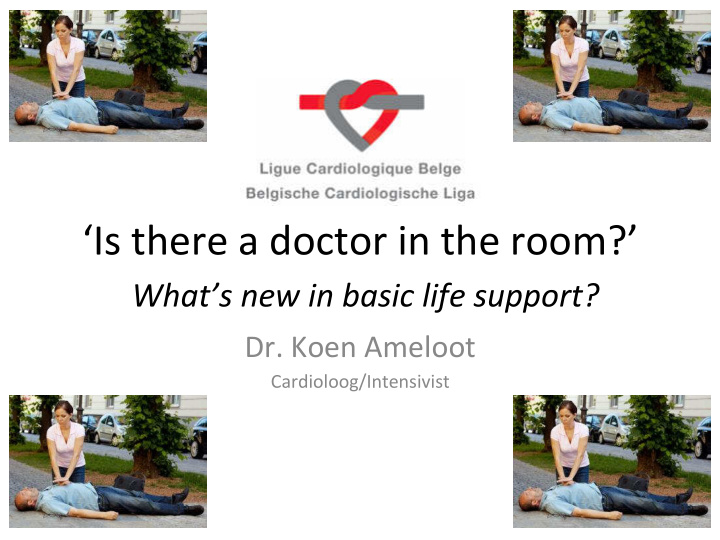



‘Is there a doctor in the room?’ What’s new in basic life support? Dr. Koen Ameloot Cardioloog/Intensivist
That morning in your wai?ng room…
OOHCA is frequent
Survival aMer OOHCA is poor 30 pt/d 15% 35% 5% 60 %
Early Recogni?on How sudden is sudden cardiac death? Preventable? Muller, circula?on 2006
Early Recogni?on How to recognize CA? 1. Unconsciousness 2. Abnormal breathing !! Gasping = CA !! Seizures…
Early Recogni?on How to recognize CA? • 29% of CA are not recognized by telephone • Unrecognized CA à worse prognosis • Normal breathing never present in true CA Berdowski, circula?on 2009
Early CPR Basic life support doubles survival NEJM 2015
Early CPR Basic life support training works NEJM 2015
Early CPR Technology might help NEJM 2015
Early CPR Technology might help NEJM 2015
Early CPR What about CPR devices?
Early CPR CPR devices do not improve outcome LINC trial, JAMA, 2014
That morning in your wai?ng room…
Early CPR
Early CPR
Early CPR • In the center of the chest • 30:2 ra?o • 100-120/min • 5cm compression depth • Chest wall recoil • Firm surface • Minimizing pauses
Early CPR • In the center of the chest • 30:2 raEo • 100-120/min • 5cm compression depth • Chest wall recoil • Firm surface • Minimizing pauses Babbs, Resuscita?on 2002
Early CPR • In the center of the chest • 30:2 raEo • 100-120/min • 5cm compression depth • Chest wall recoil • Firm surface • Minimizing pauses REA, NEJM 2010
Early CPR • In the center of the chest • 30:2 raEo • 100-120/min • 5cm compression depth • Chest wall recoil • Firm surface • Minimizing pauses Svenson, NEJM 2010
Early CPR • In the center of the chest • 30:2 ra?o • 100-120/min • 5cm compression depth • Chest wall recoil • Firm surface • Minimizing pauses Idris, Circula?on 2012
Early CPR • In the center of the chest • 30:2 ra?o • 100-120/min • 5cm compression depth • Chest wall recoil • Firm surface • Minimizing pauses S?el, circula?on 2014
Early CPR • In the center of the chest • 30:2 ra?o • 100-120/min • 5cm compression depth • Chest wall recoil • Firm surface • Minimizing pauses Cheskes, circula?on 2011
Early defibrilla?on Valenzuela, circula?on 1997
Early defibrilla?on
Early defibrilla?on • 2 yrs aMer placement AED in Chicago Airport: 21 OOHCA (18 VF and 3 asystole) No AED < 5 min 4/18 (22%) 0% Survival AED < 5 min 14/18 (78%) 78% survival NEJM 2003
VF VT Asystole PEA
Amiodarone vs lidocaine vs placebo in out of hospital cardiac arrest. NEJM 2015
BMJ 2016
ROSC na 20’ ALS
Post-ROSC
Angiography for all? 1. Post-ROSC ECG is a bad predictor of a coronary occlusion 2. Associa?on between PCI and beier prognosis aMer OOHCA (inclusionbias) Spaulding, NEJM 1997
Coronary Angiography
Literature Roberts, circula?on 2013
Literature Kilgannon, circula?on 2011
Bernard, NEJM 2002 Nielsen, NEJM 2013
#1 Timely referral before CA #2 Unconscious with abnormal breathing paiern #3 In the center of the chest, 30:2 ra?o, 5cm compression, 100-120/min, firm surface, allow recoil #4 BLS doubles survival #5 BLS training works #6 Early defibrilla?on with AED #7 Post-ROSC care with temperature control, early revasculariza?on and adequate oxygena?on
Recommend
More recommend